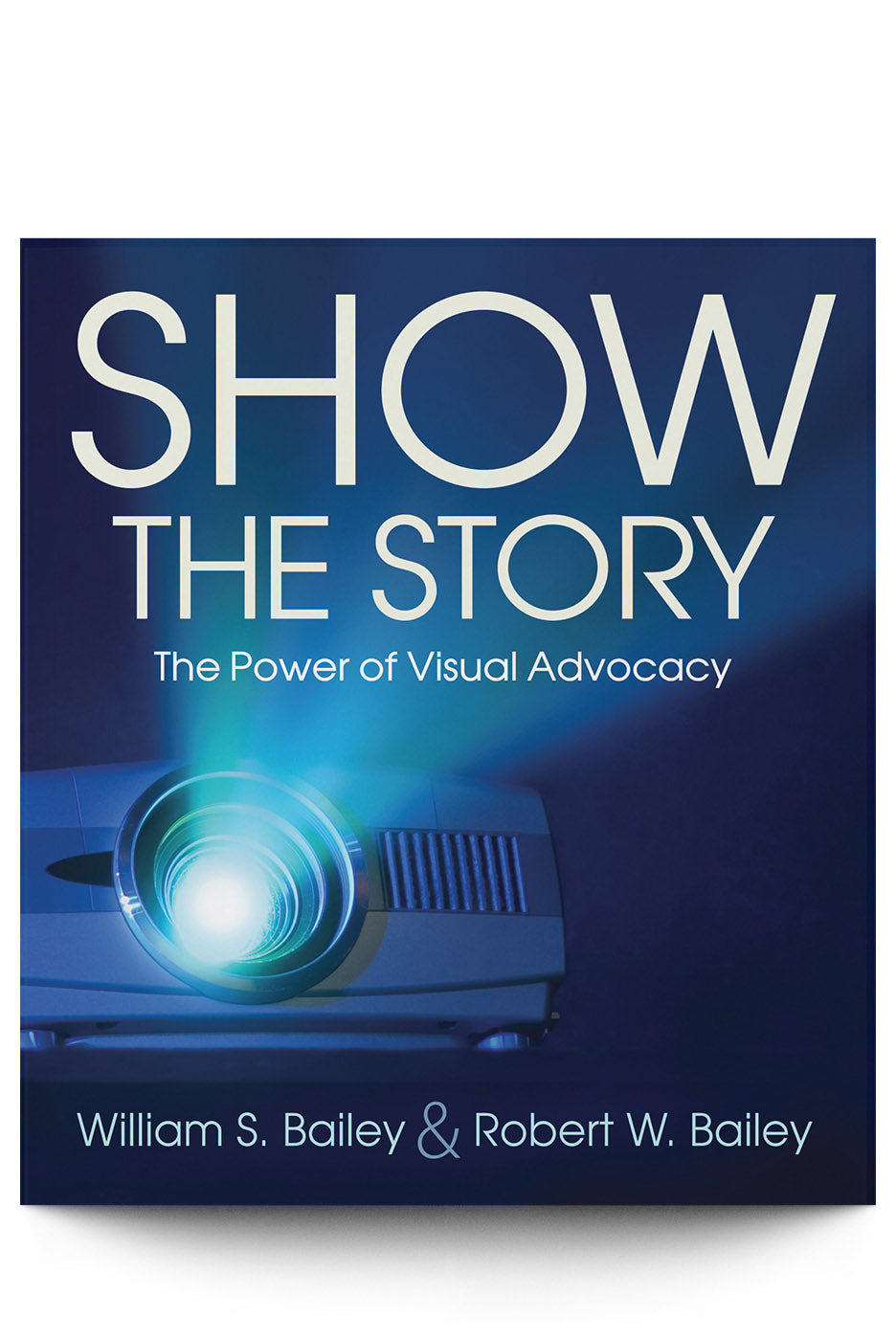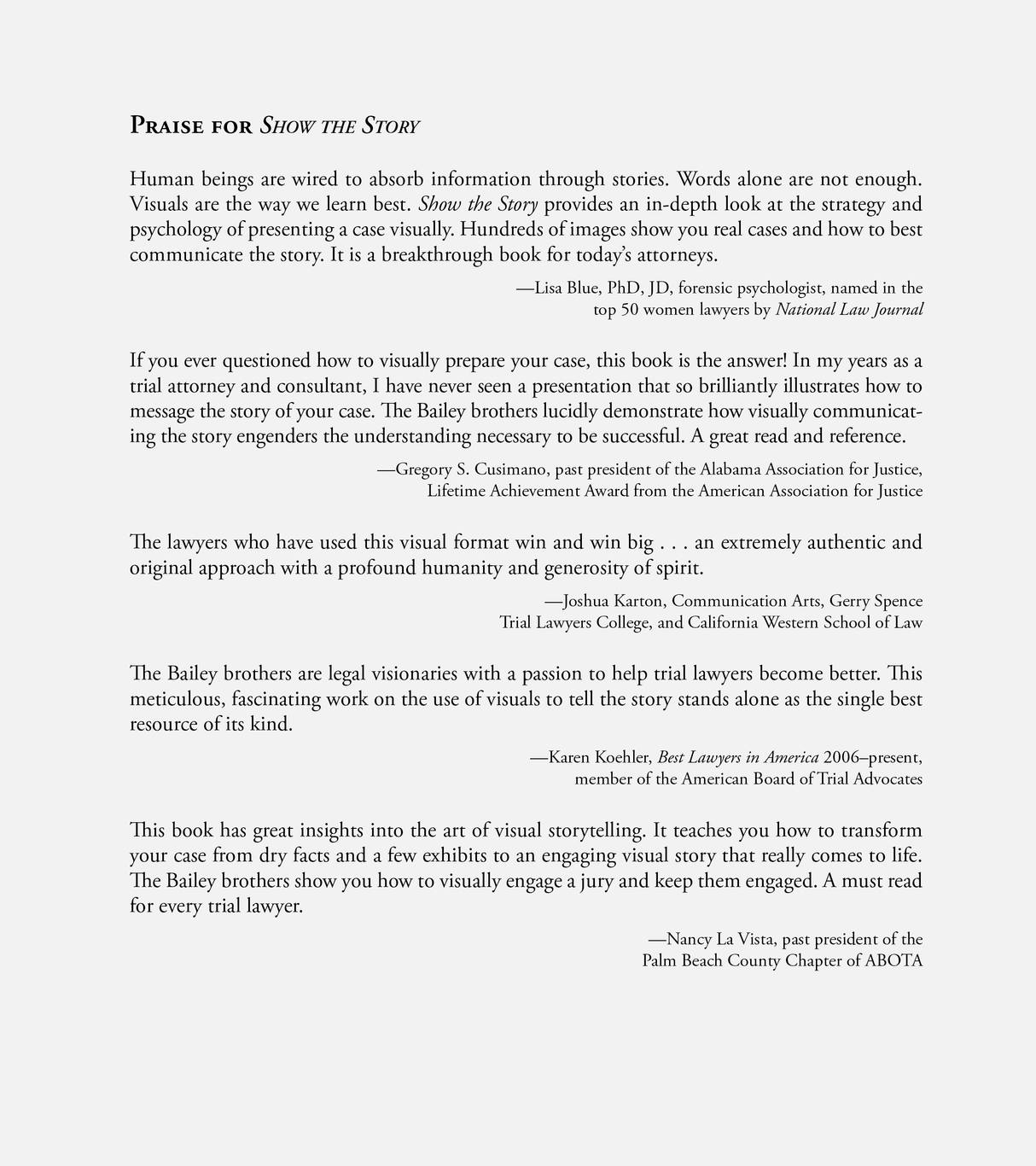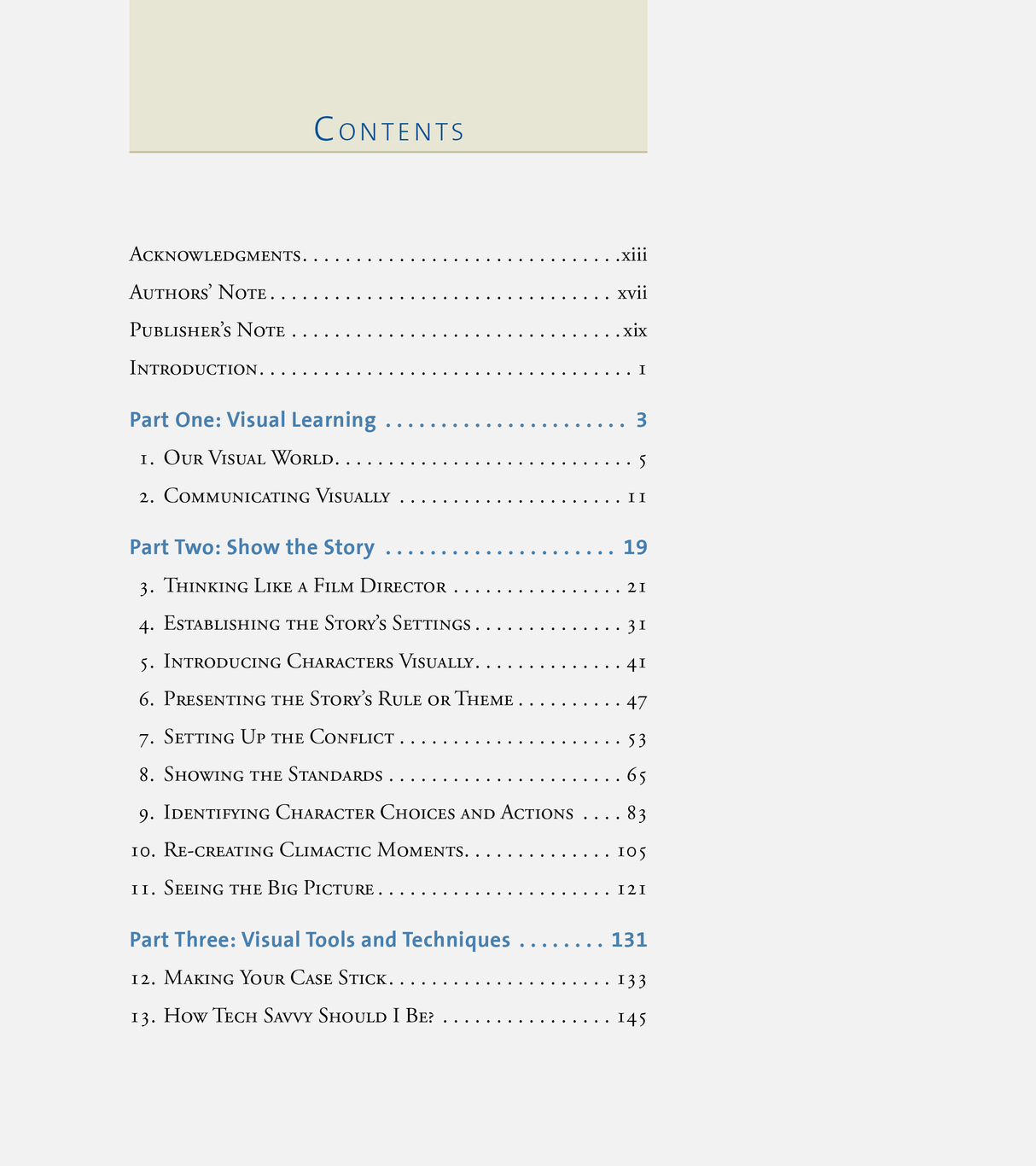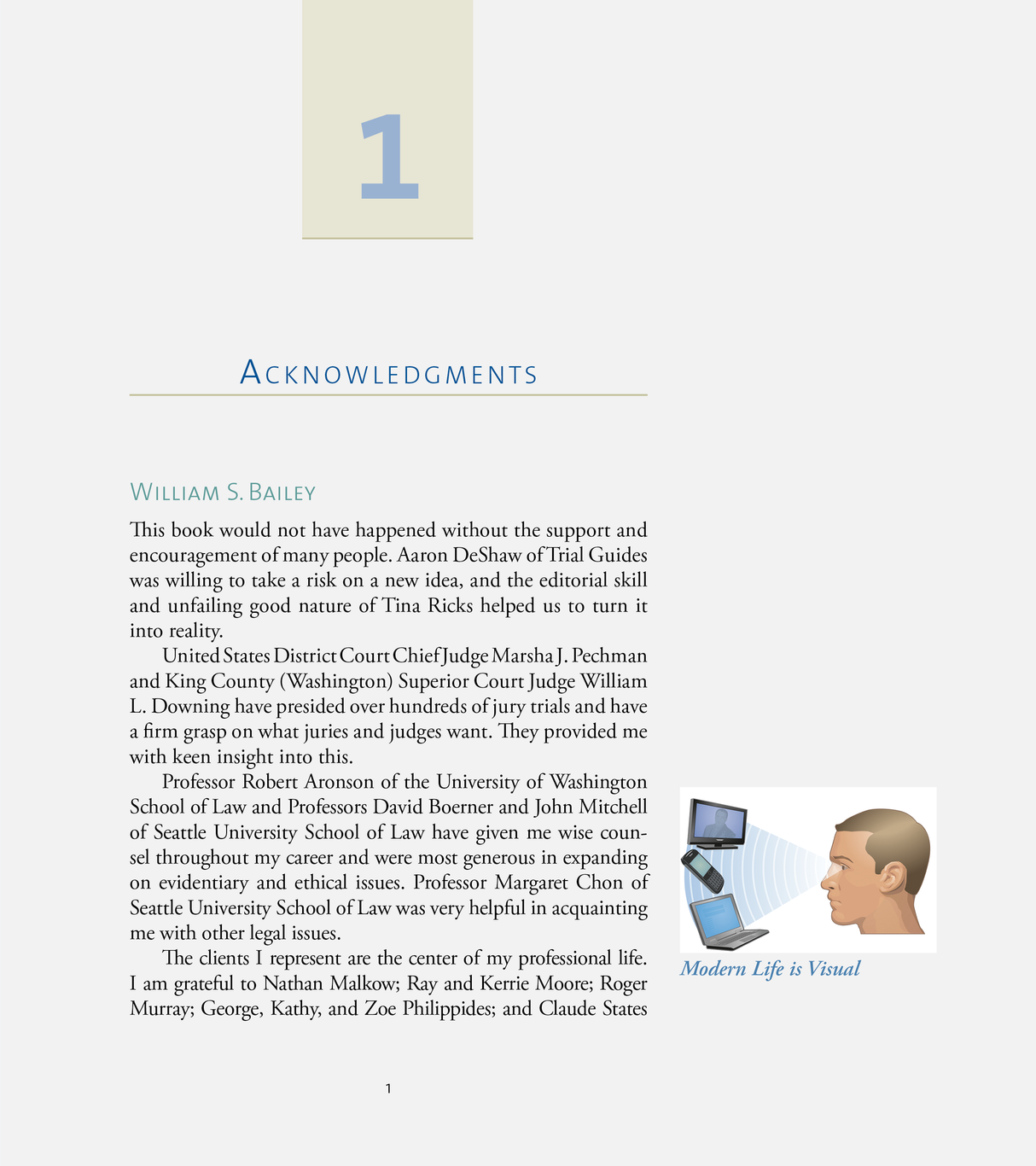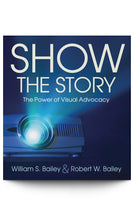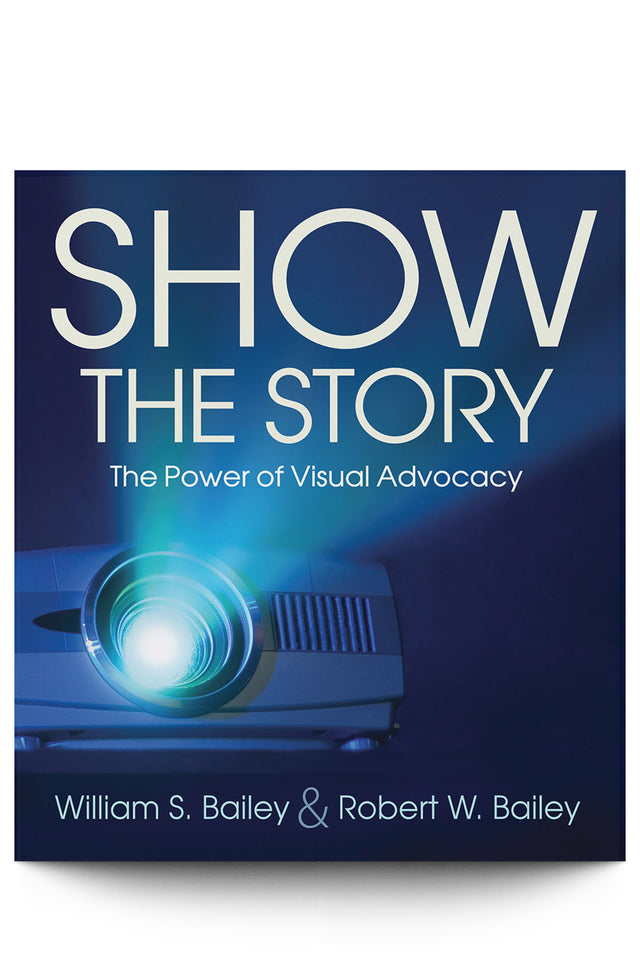Description
Description
When you litigate a case, you know every detail intimately. You know your client, you've seen their injuries at the worst, you've been to the accident scene, and commiserated with the witnesses. The mediator, the judge, the jury—they have nothing more than the series of words you string together. That is, unless, you Show the Story. In this groundbreaking work by attorney William Bailey and trial consultant Robert Bailey, you'll learn to create compelling visual presentations and make your cases come alive. This is more than a simple poster board or powerpoint slide. It's learning how to tell a story in pictures—presenting the setting, the defendant, the actions, and the defendant's choices in images. What happened, and when did it happen?
The authors explain how to get the judge to allow your graphic presentation, with extensive discussions about what meets the standards for evidence. You'll learn how to work with a graphic arts professional in getting the right information to the artist, and when and how to involve your client. You'll also learn strategies for making sure your story in pictures gets in to the jurors' and decision makers' heads—and stays there—throughout the trial and into deliberations.
This masterpiece on visual communication teaches you to think in pictures, then present those pictures in a compelling way to your audience. Filled with examples, presentations used in actual cases, and step-by-step instructions, Show the Story is your key to becoming an effective visual communicator in the courtroom and in conferences.
Authors
Authors
Details
Details
Paperback: 428 pages; 1st edition (2011); ISBN: 978-1934833384
Publisher: Trial Guides, LLC
Table of Contents
Table of Contents
- Introduction
- Part I: Visual Learning
- Our Visual World
- Communicating Visually
- Part II: Show the Story
- Thinking Like a Film Director
- Establishing the Story's Settings
- Introducing Characters Visually
- Presenting the Story's Rule of Theme
- Setting Up the Conflict
- Showing the Standards
- Identifying Character Choices and Actions
- Re-creating Climactic Moments
- Seeing the Big Picture
- Part III: Visual Tools and Techniques
- Making Your Case Stick
- How Tech Savvy Should I Be?
- Employing the Locus in Quo
- Building the Theme
- Creating Computer Illustrations and Animations
- Working with Computer-Graphics Specialists
- Avoiding the Pitfalls
- Exmaining Computer-Illustration Case Studies
- Creating Illustrations from Source Material
- Using Google Earth
- Part IV: Visual Foundation
- Hearing a Judge's Perspective
- Dealing with Evidentiary and Ethical Issues
- Enhancing Reality
- Expanding Traditional Evidence Rules
- Winning an Admissibility Knife Fight
- Turning the Weapon Around: Defense into Offense
- The Future Is Now
- Appendices
- A. Defending with Visuals
- B. The Defense Playbook
Also included with book: DVD with sample animations
Free Chapter Sample
Free Chapter Sample
What Legal Leaders Are Saying
— David A. Wenner, Co-creator of the Jury Bias Model™Trial lawyers who have had the privilege of working with Robert Bailey on a case recognize his film director like brilliance in telling the trial story. Finally, there is a book that teaches trial lawyers how Bailey works his magic. Fortunately, this book is collaboration between Robert and his brother, William, who is one of those rare trial lawyers who understands how the use visual imagery to persuade. Together these two teach us how transform our case into winning story. Every trial lawyer needs this book!
— Howard L. Nations, president of the National Trial Lawyers Association, Adjuner Law Professor at South Texas College of LawIn this age when visual persuasion and storytelling are the hallmarks of successful litigation, William and Robert Bailey have captured the essence of the genre. This is a comprehensive and highly valuable book, rich with ideas, illustrations and superb content. It will benefit all trial lawyers, whether novice or experienced.
— Kathleen Flynn Peterson, fellow of the American College of Trial Lawyers, past president of the American Association for JusticeIf lawyers employ the sophisticated visual strategies presented in this book they will have a distinct advantage over those who do not. All will benefit greatly from this text. Bravo!
— Ron Rouda, Lifetime Achievement Award, American Board of Trial Advocates 2011, and fellow of the International Academy of Trial LawyersI highly recommend that practicing attorneys in the field of personal injury and wrongful death litigation read and use Show the Story. It explains how to use visual tools and techniques to tell the story of the case.
— Paul Scoptur, co-chair of the National College of Advocacy Board of Trustees, Adjunct Professor of Law at Marquette University Law SchoolThis is one book that will be on my bookshelf and will be required reading for all lawyers in my firm. Accomplished trial lawyer William Bailey gives us all the tools we need to tell the visual story of the trial. Trial consultant Robert Bailey is the best visual trial storyteller in the country. Thank you for showing us the visual story.
— Mike Wampold, Adjunct Professor at the University of Washington School of Law, National Institute of Trial Advocacy Instructor, 2003-presentI love it! It is a classic. It will be bought by every real trial lawyer in the country. This is the Bible for using visuals in trial. Wow!
— Frederick C. Moss, Professor of Law (Emeritus), Dedman School of Law, Southern Methodist UniversityI was blown away by this book. It brings Melvin Belli’s breakthrough into the 21st century. I was very impressed at the depth of the book, the psychology of learning and remembering, and the judges’ perspectives. This is invaluable stuff. Well done.
— Troy D. Chandler, Lead Counsel, WilliamsThis particular case involved a property management company that failed to inform the residents of an apartment complex that a sexual predator had attacked two other women living on the premises. As a result, my client, a professional workingwoman who lived by herself, was repeatedly raped for twelve hours in her apartment. After reading Show the Story, I consulted with co-author Robert Bailey, who is a 20-year trial consultant specializing in visual communication and story development. He helped me think about my case more creatively and showed me how to bring it to life visually using the techniques described in Show the Story. As a result, I developed the liability story of my case in an entirely different way than I was accustomed. Instead of relying primarily on words and documents, I used a visual documentary style of presentation. Utilizing the same visual strategies described in the book, I then presented my client’s damages story through moving imagery, powerful sequencing, and unspoken communication, breaking through the normal accounting of facts, and grabbing hold of the visual drama that brought to life my client’s emotional story. The evidence laid itself out in such a powerful fashion that the jury was left with no other choice but to find fault with the defendant. The result: the jury awarded plaintiff $20 million dollars, twice the amount we were asking ($7 million for past mental anguish and physical suffering, $5 million for future suffering and $8 million for the conduct of the apartment owners). The jury foreperson said to all assembled lawyers, ‘We would have given you even more if you would have asked for it.’ Even the bailiff of twenty years who has seen hundreds of trials said, ‘This was the best opening I have ever seen.’
— Justice Tom Chambers, Washington State Supreme CourtThe Baileys have perfected their craft to an Academy Award level. They use classic movies, animations, judges, Google Earth, and loads of illustrations to tell the story. The book teaches the right mix between high tech and butcher paper, and the ethical limits too. It is a captivating read and a must for any trial lawyer’s library.
— Joshua Karton, Communication Arts for the Professional, Trial Lawyers College, and California Western School of LawThe lawyers who have used this visual format win and win big … an extremely authentic and original approach with a profound humanity and generosity of spirit.
— Karen Koehler, listed in Best Lawyers in America 2006-present, member of the American Board of Trial AdvocatesThe Bailey brothers are legal visionaries with a passion to help trial lawyers become better. This meticulous, fascinating work on the use of visuals to tell the story stands alone as the single best resource of its kind.
— Nancy La Vista, past president of the Palm Beach County Chapter of ABOTAThis book has great insights into the art of visual storytelling. It reaches you how to transform your case from dry facts and a few exhibits to an engaging visual story that really comes to life. The Bailey brothers show you how to visually engage a jury and keep them engaged. A must read for every trial lawyer.
— Robert F. Linton, Jr., past president of the Cleveland Academy of Trial Attorneys, named an Ohio Super Lawyer 2007-2011You’ve pioneered a radical way to look at our cases. This book shows not only how to make a winning visual story, but how to persuade through sequencing information properly. Your methods have helped us obtain millions in verdicts for our clients.
— Paul Luvera, past president of the Inner Circle of Advocates, member of the International Academy of Trial LawyersThe Bailey brothers have written an encyclopedia of information about showing your clients story to the jury through visual presentations with clear instructions about how to do it correctly. It should be in every trial lawyer’s library. It’s a winner.
— Tommy Malone, member of the International Society of Barristers, named in Best Lawyers in America 1989-presentThe Bailey brothers have made an invaluable contribution to the trial bar and those we serve. Show the Story is for those who aspire to be the very best.
— Mark Mandell, past president of the American Association for JusticeA valuable road map that teaches us how to visually frame and sequence our trial and settlement presentations. The lessons of Show the Story will definitely enhance our likelihood of success.

